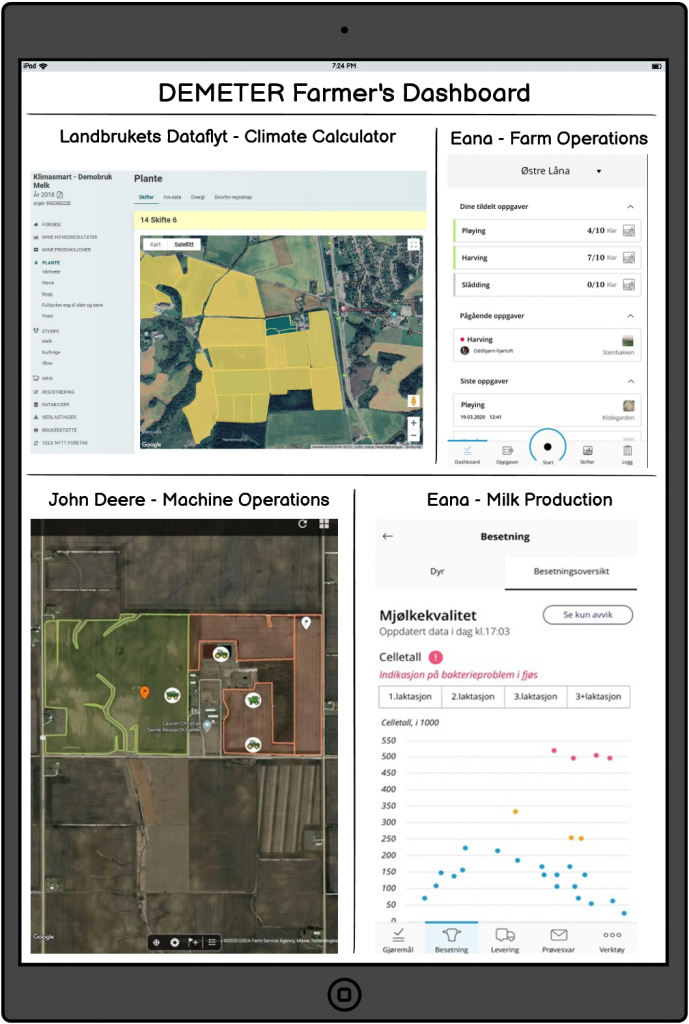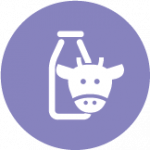PILOT 4.1 Dairy Farmers' Dashboard for the Entire Milk and Meat Production Value Chain

CHALLENGE
Farmers have to handle an increasing number of digital systems and solutions that affect their daily work as well as production and investment decisions. Today’s digital solutions do not communicate or integrate well enough together and are not largely based on the needs of the farmer. In addition, administrative and production systems produce different types of data that is difficult to use for decision support. Thus, the dataflow for farmers is a big challenge and equally an opportunity for business development in the sector.
AIM
The main aim of this pilot is to develop a farmer’s digital dashboard delivering a better view or outlook of the farm activities and the farmer’s cooperation with both private and public actors. This will ensure a more efficient use of digital tools by the farmer and a better and more customised decision support. In addition over time, the pilot aims to develop a new system for data collection, modelling and calculation of greenhouse gas emissions on farm level, and a new model for milk prognosis that are essential to optimise production in economic terms, animal numbers, milk quality and feed production.
HOW
With regard to the farmers’ dashboard element of the pilot, Agricultural Dataflow, pilot partner, will build data infrastructure and models of farmers’ dashboard for external suppliers, researchers, farmers and advisors. These are based on the existing dataflow infrastructure that 14,000 farmers use and the systems that are developed in technical parts of DEMETER. In the development process, farmers and related partners and industries in Norway will be involved. New apps and solutions for Norwegian farmers will be launched with easier registration and insight to continuously improve production. The focus from pilot partner, Mimiro is to use data from more than 500 dairy farms with automatic milking systems and apply machine learning techniques to develop algorithms for milk yield forecasting and culling strategy.
BENEFIT
The main benefits of developing a farmer’s dashboard are more efficient production and better investment decisions. In addition, there are benefits for related partners with data access and solutions that optimise their production and activities. The pilot is expected to share knowledge and solutions regarding the main decision variables for each farmer and how these variables can be presented in one overall dashboard. It will also give information on how to get system suppliers and partners of the farmers to cooperate and interact, sharing data and web-interfaces. The cost-benefit for the farmer, related businesses and society will be detailed and what business models can be used for the developed tools in the pilot will be outlined.

LIVESTOCK
FOCUS: Animal Health, High Quality & Optimal Management of Animal Products.
LOCATION

Norway
PARTNERS




Pilot projects run under pilot cluster four:
Pilot 4.1 - Dairy Farmers’ Dashboard for the Entire Milk and Meat Production Value Chain
Dairy Farmers’ Dashboard for the Entire Milk and Meat Production Value Chain
Farmers have to handle an increasing number of digital systems and solutions that affect their daily work as well as production and investment decisions. Today’s digital solutions do not communicate or integrate well enough together and are not largely based on the needs of the farmer.
Pilot 4.2 - Consumer Awareness: Milk Quality and Animal Welfare Tracking Management
Consumer Awareness: Milk Quality and Animal Welfare Tracking Management
Many farmers already monitor their animals by using different smart devices which collect data in a scattered way. However, they often miss an overall vision of the most important animal welfare and milk yield indicators. In addition, processing companies…
Pilot 4.3 - Proactive Milk Quality Control
Proactive Milk Quality Control
Traditional farming involved management systems based on direct observation of animals and intuitive decision making by the farmer. Larger animal numbers and reduced available time of the farmer have necessitated changes, potentially resulting in less available time to observe and detect welfare and health issues of individual animals.
Pilot 4.4 - Optimal Chicken Farm Management
Optimal Chicken Farm Management
Growing food demand has increased the need for animal protein. This need currently exceeds the demand by 1.7% per year, resulting in global annual poultry production reaching over 103.5 million tons (Foreign Agricultural Service/USDA, Livestock and Poultry: World Markets and Trade). To meet growing demands…


